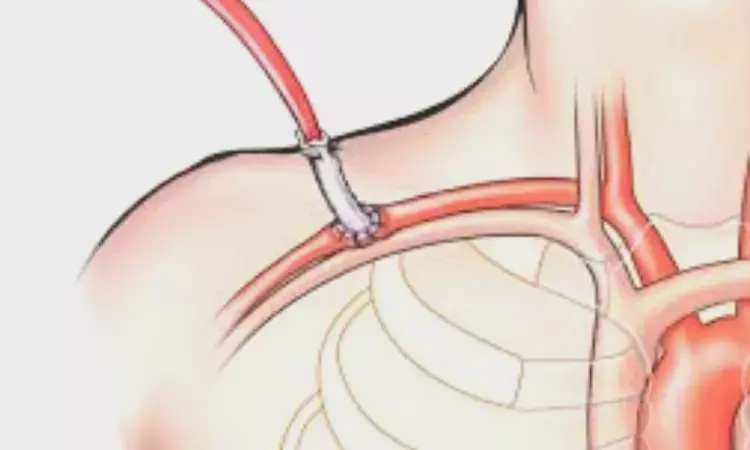- Home
- Medical news & Guidelines
- Anesthesiology
- Cardiology and CTVS
- Critical Care
- Dentistry
- Dermatology
- Diabetes and Endocrinology
- ENT
- Gastroenterology
- Medicine
- Nephrology
- Neurology
- Obstretics-Gynaecology
- Oncology
- Ophthalmology
- Orthopaedics
- Pediatrics-Neonatology
- Psychiatry
- Pulmonology
- Radiology
- Surgery
- Urology
- Laboratory Medicine
- Diet
- Nursing
- Paramedical
- Physiotherapy
- Health news
- Fact Check
- Bone Health Fact Check
- Brain Health Fact Check
- Cancer Related Fact Check
- Child Care Fact Check
- Dental and oral health fact check
- Diabetes and metabolic health fact check
- Diet and Nutrition Fact Check
- Eye and ENT Care Fact Check
- Fitness fact check
- Gut health fact check
- Heart health fact check
- Kidney health fact check
- Medical education fact check
- Men's health fact check
- Respiratory fact check
- Skin and hair care fact check
- Vaccine and Immunization fact check
- Women's health fact check
- AYUSH
- State News
- Andaman and Nicobar Islands
- Andhra Pradesh
- Arunachal Pradesh
- Assam
- Bihar
- Chandigarh
- Chattisgarh
- Dadra and Nagar Haveli
- Daman and Diu
- Delhi
- Goa
- Gujarat
- Haryana
- Himachal Pradesh
- Jammu & Kashmir
- Jharkhand
- Karnataka
- Kerala
- Ladakh
- Lakshadweep
- Madhya Pradesh
- Maharashtra
- Manipur
- Meghalaya
- Mizoram
- Nagaland
- Odisha
- Puducherry
- Punjab
- Rajasthan
- Sikkim
- Tamil Nadu
- Telangana
- Tripura
- Uttar Pradesh
- Uttrakhand
- West Bengal
- Medical Education
- Industry
Type A acute aortic dissection still carries high mortality risk in contemporary era, JAMA study reveals

USA: Type A acute aortic dissection (TAAAD) still carries a high death risk in patients not receiving surgery, researchers suggest in a cohort study published in JAMA Cardiology.
The study found that in the contemporary era, the overall mortality rate for TAAAD was 5.8% at 48 hours. The mortality rate of TAAAD for patients in the medical group was 0.5% per hour (23.7% at 48 hours). The 48-hour mortality, however, decreased to 4.4% among those in the surgical group.
Early data showed a mortality rate of 1% to 2% per hour for acute type A aortic dissection during the initial 48 hours. This mortality rate continues to be cited despite advances in diagnostic testing and treatment. The reason for this could be a lack of contemporary data characterizing early mortality and the effect of timely surgery.
Against the above background, Kevin M. Harris, Minneapolis Heart Institute Foundation, Abbott Northwestern Hospital, Minneapolis, Minnesota, and colleagues examined data for patients with TAAAD in the International Registry of Acute Aortic Dissection between 1996 and 2018. Grouping of the patients was done according to the mode of their intended treatment, medical or surgical.
Assessment of mortality was done in the initial 48 hours following hospital arrival using Kaplan-Meier curves. The evaluation of in-hospital complications was also done.
The researchers identified a total of 5611 patients with TAAAD based on intended treatment: 91.4% in the surgical group (67.1% male; mean age, 60.4 years) and 8.6% in the medical group (52.5% male; mean age, 70.9 years).
The key findings of the study were as follows:
- Reasons for medical management included advanced age (n = 141), comorbidities (n = 281), and patient preference (n = 81).
- Over the first 48 hours, the mortality for all patients in the study was 5.8%.
- Among patients who were medically managed, mortality was 0.5% per hour (23.7% at 48 hours).
- For those whose intended treatment was surgical, 48-hour mortality was 4.4%.
- In the surgical group, 51 patients (1%) died before the operation.
"In the contemporary era, the mortality rate in patients recognized with TAAAD in the first 48 hours is 0.12% per hour," the researchers wrote in their study. This rate is lower compared to that reported in the 1950s and could be due to advances in surgery, imaging, and medical treatment over the past 60 years, they explained.
48-hour mortality of medically managed patients in this study was 23.7% or 0.5% per hour. Patients who are deemed eligible for repair, most of whom ultimately receive surgery, have a lower mortality risk, with 4.4% mortality after 2 days. Importantly, a subgroup of initially stable patients experienced catastrophic and often unforeseen complications, including aortic rupture and cardiac tamponade and, and died before surgery.
"These data serve as a sobering reminder that TAAAD merits efforts to improve recognition, as well as rapid transfer and surgical treatment protocols," the authors conclude.
Reference:
Harris KM, Nienaber CA, Peterson MD, et al. Early Mortality in Type A Acute Aortic Dissection: Insights From the International Registry of Acute Aortic Dissection. JAMA Cardiol. Published online August 24, 2022. doi:10.1001/jamacardio.2022.2718
Dr Kamal Kant Kohli-MBBS, DTCD- a chest specialist with more than 30 years of practice and a flair for writing clinical articles, Dr Kamal Kant Kohli joined Medical Dialogues as a Chief Editor of Medical News. Besides writing articles, as an editor, he proofreads and verifies all the medical content published on Medical Dialogues including those coming from journals, studies,medical conferences,guidelines etc. Email: drkohli@medicaldialogues.in. Contact no. 011-43720751


